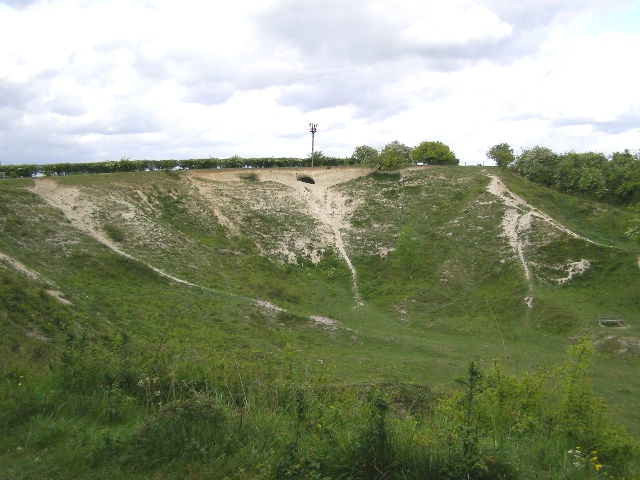Clunch

|
| The Orwell Clunch Pit, near Cambridge, is a medieval quarry that was designated a Site of Special Scientific Interest (SSSI) in 1985. |
[edit] Introduction
Clunch is a form of soft, chalky limestone rock that closely resembles chalk and shares many of its characteristics, but with lower density. It is used mainly in eastern England and Normandy.
The term is also generically applied to soft, inferior building stone that is used in place of stronger, more desirable material.
[edit] Characteristics
In its freshly quarried state, clunch is soft and holds water, which makes it easier to cut. Once dry, it hardens and becomes more difficult to cut.
Clunch was used extensively in medieval times as a building material. It was often used for chimneys, property boundary walls and small agricultural buildings.
It was not suitable for large scale use, since it would easily erode when exposed to chemicals or severe weather. Structures made from clunch had to be protected with paint, cement or stucco and could then be finished with a lime wash.
However, even when the surfaces were covered, clunch was not especially durable and could even be damaged by frost. Despite this, it was often used in certain parts of the country, since it was inexpensive and widely available.
[edit] Related articles on Designing Buildings Wiki
Featured articles and news
One of the most impressive Victorian architects. Book review.
RTPI leader to become new CIOB Chief Executive Officer
Dr Victoria Hills MRTPI, FICE to take over after Caroline Gumble’s departure.
Social and affordable housing, a long term plan for delivery
The “Delivering a Decade of Renewal for Social and Affordable Housing” strategy sets out future path.
A change to adoptive architecture
Effects of global weather warming on architectural detailing, material choice and human interaction.
The proposed publicly owned and backed subsidiary of Homes England, to facilitate new homes.
How big is the problem and what can we do to mitigate the effects?
Overheating guidance and tools for building designers
A number of cool guides to help with the heat.
The UK's Modern Industrial Strategy: A 10 year plan
Previous consultation criticism, current key elements and general support with some persisting reservations.
Building Safety Regulator reforms
New roles, new staff and a new fast track service pave the way for a single construction regulator.
Architectural Technologist CPDs and Communications
CIAT CPD… and how you can do it!
Cooling centres and cool spaces
Managing extreme heat in cities by directing the public to places for heat stress relief and water sources.
Winter gardens: A brief history and warm variations
Extending the season with glass in different forms and terms.
Restoring Great Yarmouth's Winter Gardens
Transforming one of the least sustainable constructions imaginable.
Construction Skills Mission Board launch sector drive
Newly formed government and industry collaboration set strategy for recruiting an additional 100,000 construction workers a year.
New Architects Code comes into effect in September 2025
ARB Architects Code of Conduct and Practice available with ongoing consultation regarding guidance.
Welsh Skills Body (Medr) launches ambitious plan
The new skills body brings together funding and regulation of tertiary education and research for the devolved nation.
Paul Gandy FCIOB announced as next CIOB President
Former Tilbury Douglas CEO takes helm.























